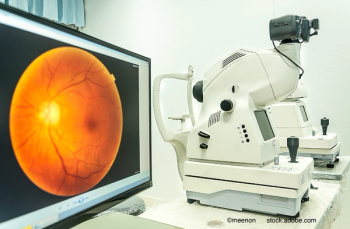
Assessing the impact of FLACS on surgical outcomes
FLACS is related to an increase of anterior chamber prostaglandin and cytokines, resulting in intra-operative miosis. This can be prevented by pre-operative non-steroidal anti-inflammatory drug application. As a result of methodological problems, several studies on the association between femtosecond laser-assisted cataract surgery and cystoid macular oedema are inconclusive.
The femtosecond laser is an infrared laser with a wavelength of 1,053 nm that operates at high energy levels and very short, femtosecond range, pulses. Femtolasers, such as the Nd:YAG laser, work by producing photodisruption or photoionization of the optically transparent tissue, such as the cornea.
Femtosecond lasers were previously used primarily for corneal surgery. However, technical development enabled the first application in cataract surgery for capsulorrhexis and lens fragmentation in August 2008, which was achieved by Dr Zoltan Z. Nagy at Semmelweis University in Budapest.
Femtosecond lasers were believed to have revolutionised cataract surgery. However, despite the promise, the assessment of perceived benefits has proven to be far more complicated than was initially thought. In a recent review by Popovic et al.
However, FLACS showed statistically significant differences for several secondary surgical outcomes, i.e., decreased effective phacoemulsification time; enhanced capsulotomy circularity; lower postoperative central corneal thickness; and corneal endothelial cell reduction.
Cystoid macular oedema
Cystoid macular oedema (CME) (Figure 1) following cataract surgery remains the most common cause of poor visual outcome. Whereas acute pseudophakic CME may resolve spontaneously, some patients will suffer from vision impairment and will be difficult to treat.
Published studies use different methodologies, which primarily depend on clinical observation of cystoid changes; leakage shown by fluorescein angiography; or increased thickness shown by OCT along with some degree of visual impairment.
Although pseudophakic CME was described about 50 years ago, the pathophysiology remains uncertain and various pathomechanisms were suggested.
It is postulated that surgical manipulation within the anterior chamber may lead to the release of arachidonic acid from uveal tissue, with the production of either leukotrienes via the lipoxygenase pathway or prostaglandins (PGs) via the cyclooxygenase pathway.
Subsequently, the mediators of inflammation might diffuse posteriorly into the vitreous resulting in breakdown of the blood-retinal barrier. This disruption results in increased permeability of the perifoveal capillaries and fluid accumulation within the retina.
The first report on the influence of FLACS on macular thickness was published by Ecsedy et al.
The difference in the inner macular ring thickness between groups was 21.68 μm 1 week after surgery and 17.56 μm after 1 month. Although the disparity did not achieve statistical significance, multivariable modelling showed lower macular thickness in the inner retinal ring in the laser group after adjusting for age and preoperative thickness.
Another study by the same authors compared the outer nerve layer thickness in 12 eyes of 12 patients undergoing FLACS versus 13 eyes of 13 patients undergoing PCS.
Femtosecond theories
The mechanisms leading to CME in FLACS are unknown. It is presumed that, in general, near-infrared lasers, such as the femtosecond laser, pass easily with little absorption through the nonpigmented tissues i.e., the cornea, aqueous humour or lens. However, as a result of the absorption by melanosomes in the pigmented layer of the retina and choroid there might be an increased risk of damage.
Furthermore, femtosecond laser pulses during pretreatment may cause shockwaves that communicate with surrounding anterior ocular structures (e.g., the iris and ciliary body), leading to mechanical microtrauma.
The formerly mentioned factors might result in PG release during FLACS. A study by Schultz et al.
The levels of both PG and PGE2 increased following FLACS compared with PCS in all populations. No correlation between PG/PGE2 ratio and cataract density; corneal incision; suction time; or laser time was found. The authors concluded that PG levels rise immediately after FLACS.
Another study
Anterior capsulotomy was found to be the main trigger for increased aqueous humour PG levels. With that, Wang et al.
Further investigations focused on the inhibition of PG release. A study by Kiss et al.
In the FLACS surgery group, nepafenac was administered three times daily on the day before surgery and on the morning of the surgery day. Preoperative 1-day-long nepafenac treatment prior to FLACS prevented the rise of intracameral PG concentration.
The final PG concentration following FLACS was lower than before PCS. Another consecutive case series was conducted by Jun et al.
Miosis is a major disadvantage of FLACS versus PCS because miosis during the phacoemulsification can substantially increase surgical complications. PGE2 release has been suggested as an underlying causative factor, although a precise mechanism has not been fully determined.
Jun et al.
A study by Conrad-Hengerer et al.
In a study by Levitz et al.
Contrast studies by Ewe et al. revealed an increased risk for CME after FLACS. In their first study
A trend toward greater CME in the FLACS group was found (p = 0.07). A limitation of the study was the nonspecified number of cases with diabetic retinopathy or retinal disease. Furthermore, of the seven cases developing CME subsequently to FLACS, four occurred in two patients.
In 2016
As OCT can detect early, subclinical retinal thickening in people without a significant macular oedema, it plays a dominant role in modern practice, particularly in macular oedema. The results of the formerly mentioned study were based solely on clinical examination, without OCT assessment.
Conclusions
As a summary, the Cochrane review comparing the outcomes of FLACS versus PCS can be presented.
Another conclusion was that complications occur rarely. For CME the evidence was inconclusive-the odds ratio was 0.58 (95% confidence interval 0.20 to 1.68). However, the nine included studies on CME manifested low certainty of evidence.
In conclusion, FLACS is related to an increase of anterior chamber PG and cytokines, resulting in intra-operative miosis. This can be prevented by pre-operative NSAID application. As a result of methodological problems, several studies on the association between FLACS and CME are inconclusive.
References
1. Chung SH, Mazur E. Surgical applications of femtosecond lasers. J Biophotonics. 2009;2:557–572.
2. Nagy ZZ, Szaflik JP. The role of femtolaser in cataract surgery. Klin Oczna. 2012;114:324–327.
3. Nagy Z et al. Initial clinical evaluation of an intraocular femtosecond laser in cataract surgery. J Refract Surg. 2009;25;1053-1060.
4. Popovic M et al. Efficacy and Safety of Femtosecond Laser-Assisted Cataract Surgery Compared with Manual Cataract Surgery: A Meta-Analysis of 14 567 Eyes. Ophthalmology. 2016;123:2113-2126.
5. Kim SJ et al. A method of reporting macular edema after cataract surgery using optical coherence tomography.
6. Tsangaridou MA et al. Controversies in NSAIDs Use in Cataract Surgery. Curr Pharm Des. 2015;21:4707-4717.
7. Grzybowski A et al. Pseudophakic cystoid macular edema: update 2016. Clin Interv Aging. 2016;11:1221-1229.
8. Ecsedy M et al. Effect of femtosecond laser cataract surgery on the macula.
9. Nagy ZZ et al. Macular morphology assessed by optical coherence tomography image segmentation after femtosecond laser-assisted and standard cataract surgery.
10. Ewe SYP et al. Cystoid macular edema after femtosecond laser-assisted versus phacoemulsification cataract surgery. J Cataract Refract Surg. 2015;41:2373-2378.
11. Schultz T et al. Changes in prostaglandin levels in patients undergoing femtosecond laser-assisted cataract surgery. J Refract Surg. 2013;29:742-747.
12. Schultz T et al.. Prostaglandin release during femtosecond laser-assisted cataract surgery: main inducer. J Refract Surg. 2015;31:78-81.
13. Wang L et al. Anterior chamber interleukin 1β, interleukin 6 and prostaglandin E2 in patients undergoing femtosecond laser-assisted cataract surgery. Br J Ophthalmol. 2016;100:579-582.
14. Kiss HJ et al. One-Day Use of Preoperative Topical Nonsteroidal Anti-Inflammatory Drug Prevents Intraoperative Prostaglandin Level Elevation During Femtosecond Laser-Assisted Cataract Surgery.
15. Jun JH et al. Effects of topical ketorolac tromethamine 0.45% on intraoperative miosis and prostaglandin E2 release during femtosecond laser-assisted cataract surgery. J Cataract Refract Surg. 2017;43:492-497.
16. Conrad-Hengerer I et al. Femtosecond laser-induced macular changes and anterior segment inflammation in cataract surgery. J Refract Surg. 2014;30:222-226.
17. Levitz L et al. Incidence of cystoid macular edema: femtosecond laser-assisted cataract surgery versus manual cataract surgery. J Cataract Refract Surg. 2015;41:683-686.
18. Ewe SYP et al. A Comparative Cohort Study of Visual Outcomes in Femtosecond Laser-Assisted versus Phacoemulsification Cataract Surgery.
19. Day AC et al. Laser-assisted cataract surgery versus standard ultrasound phacoemulsification cataract surgery. in Cochrane Database of Systematic Reviews (2016).
Dr Andrzej Grzybowski, MD, PhD, MBA
Dr Grzybowski is a professor of ophthalmology and chairman of the Department of Ophthalmology, University of Warmia and Mazury, Olsztyn, Poland. He is also head of Department of Ophthalmology at PoznaÅ City Hospital, Poland. Dr Grzybowski reports grants, personal fees and non-financial support from Bayer; non-financial support from Novartis; non-financial support from Alcon Laboratories; non-financial support from Thea; personal fees and non-financial support from Valeant; and non-financial support from Santen, outside of the submitted work.
Newsletter
Keep your retina practice on the forefront—subscribe for expert analysis and emerging trends in retinal disease management.
















































